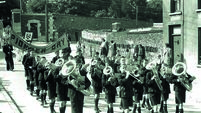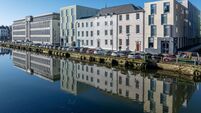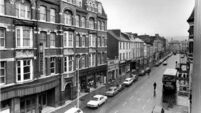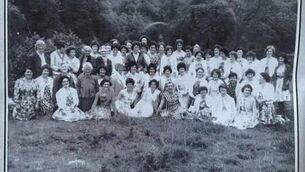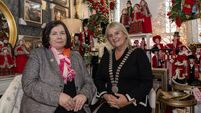Cork's moving statue shifted 25 metres...
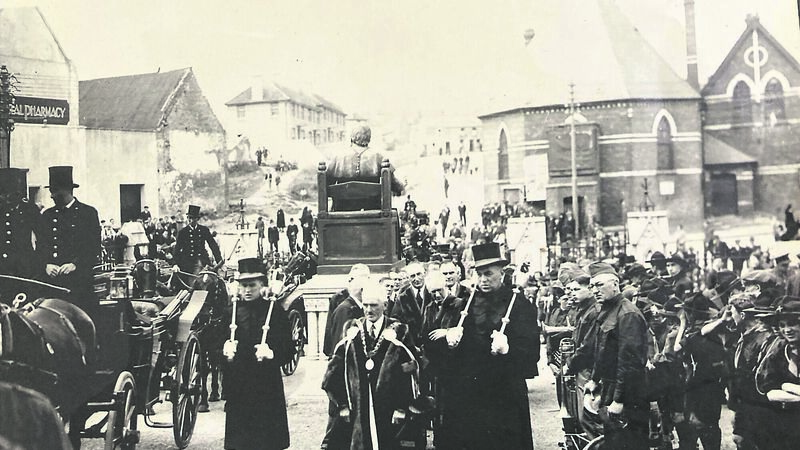
Old photo of Cathedral Road in Cork city supplied by Martin Humphreys. A reader says his grandfather is the mace bearer on the right here - John Crowley - and John’s daughter, Betty O’Mahony, shares memories of him.
THAT picture of Cathedral Road in Cork city back in the 1940s or ’50s, sent in by Martin Humphreys, to Throwback Thursday, a few weeks ago, continues to excite interest, and several readers have taken the trouble to write in with their views and information, for which we thank them heartily.
It is you who make this Throwback Thursday feature so interesting for everyone. Keep ’em coming!
Frank Roche emailed to say: “I read with interest your comments about Martin Humphreys’ Cathedral Road photo and Mary O’Leary’s reply. I had been wondering who that Lord Mayor was: the background building indicated someone who served between Sean French and Walter Furlong - some could be easily eliminated but a few remained to stump me.
“Now, the occasion. The photo was very likely taken before the St Patrick’s Day Mass of 1945.
“Stretching back to at least the late 1870s, there was a tradition of the Mayor/Lord Mayor (or his representative) leading the Catholic members of the Corporation to the Mass presided over by the Bishop (nearly always in the Cathedral) to celebrate St Patrick’s Day.
“Over the years, it developed into a formal occasion in which members of the Corporation and the Harbour Board/Commissioners participated in full regalia. They would process from the Municipal Buildings to the Cathedral and meet with the Bishop in the Presbytery across the road after the Mass. (After the burning of Cork, the Courthouse was used as the start of the procession until the City Hall was built.)”
Frank adds: “As regards the visible horse-drawn carriages, for many years the Fire Brigade accompanied the procession, led by their band, and many other organisations took part as well. I would think the carriages were used more to add to the spectacle than from any lack of alternatives - certainly carriages were being used in the 1930s long before the World War II shortages. These formal attendances continued up to at least the mid-1950s, but later ‘arrival’ photos don’t show what means of transport was used.”
Sean Cronin served as a councillor for a good number of years, continues Mr Roche, but was Lord Mayor for only one. (His father Richard, who was Lord Mayor in 1907/8, had a similar record.)
“The Examiner and the Echo reported extensively on the St Patrick’s Day Mass, and from about 1930 onwards you could expect a photo of dignitaries arriving at/inside/leaving the Cathedral on the next publication day in the Examiner. (The Echo sometimes carried the report on the same day, the 17th.)”
Frank says: “Sean Cronin, however, happened to be Lord Mayor at a time when newsprint had become exceedingly scarce due to the war: the Examiner in the mid-1940s typically had only four pages and few or no photos; the Echo was slimmed down to just two pages on most days. The years 1943-46 seem to be a rather barren period for Mayoral photos: I did a brief search but only trawled a single photo of Sean Cronin so Martin Humphreys’ photo is a fine historical addition.”

And now Frank turns to that mysterious statue from last week’s Throwback Thursday. (Catch up on that here.)
Well, it wasn’t Bishop Coholan after all, but William Delany, who held that high honour from 1847 to 1886.
Funds for the memorial, says Frank, were raised by public subscription.
“I think it was during the building of the east tower of the Cathedral in the late 1960s that the statue was moved about 25 metres to the north, where it stands today, next to the tomb of Bishop Coholan who was Bishop when Sean Cronin was in office.”
Frank Roche says he loves the variety to be found every week in Throwback Thursday, and always looks out for it. In particular, he says, he loved the account of Des Barry’s broken leg on the schoolboy rugby field. “A far cry from the era of ‘claiming’ against paramedics for malpractice! Keep up the good work.”
Then we had a delighted Jim O’Mahony making contact about that self-same Cathedral Road picture. “I just wanted to let you know that the old photo on April 6 featured my grandfather, who was the mace bearer on the right. His name was John Crowley and he was an officer in the fire station at the time.”
Now, that was a fine response, but Jim went on to tell us that his mother, Betty, a lively 85 year old, still remembers many of the events at which her father officiated. “Given his appearance in the photo, she would guess that it was in the late ’30s or early ’40s.”
Well, of course, immediate contact was made with Betty O’Mahony, and she had a wealth of information about old Cork, having grown up in the old fire station on Sullivan’s Quay.
“We actually lived over the station,” remembers Betty fondly. “We had to live there because of my father’s job as officer in the fire brigade. It was a corporation property.”
A treasured possession on her wall, says Betty, is one of her father’s fire axes that her son Jim had framed and put up for her 80th birthday. “It means the world to me, that axe, because it brings back my dad and all the major events in which he was involved. He fought Grant’s fire in 1942, Booth & Fox, 1949, and of course the Opera House fire in 1955.”
Mentioning the great old Opera House releases a flood of memories for Betty. “I loved that place. I can remember climbing up those iron steps at the side to the gods. We would go to anything we could get into, comedies, pantomimes of course, and we would go along every Monday night to see whatever show would be on. It was magical.
“The new place is a fine theatre, and with all the up to date facilities, but it will never replace the old Opera House in my heart.”
Betty feels the same way about the great old Palace, once a music hall, now lovingly cared for by the Everyman. “You get that same atmosphere there that only belongs to an old theatre that has seen so much.”
Living in the heart of the city, right on the river, Betty grew up to the sights and sounds that populate a busy urban centre. “Any parades or anything happening at all, you could look out your window and see it all. I can see all those shops still, that were to be found all along the quays back then, and if you were lucky enough to have a ha’penny or even a whole penny, you would wander the length of them, wondering where you would give your business on that particular day. You knew the ones that gave you extra weight and value, and you would always patronise them.
“Next door to the school (Sullivan’s Quay CBC) there was a sweet shop with two old ladies serving there, and you got real value for your hapenny with a square of Cleeves toffee cut off the block. That square would last you for hours!"
Betty also recalls penny toffee bars, Giftie, Black Jack, and more. And lollipops that lasted forever!
“There was a cake shop next to that sweet shop, where you got the most beautiful Thompson’s cakes. Mrs Pearl served us there. My favourite was the Snowball and then the chocolate slice. You could get crubeens there too and they took about five hours to cook.
“You know Forde’s pub? Well you couldn’t see it back then, because the shops were in front of it, and it was on the lane behind. You can see the pub now because the old shops are gone. I don’t know what happened to them. They were almost attached to the school, and probably got a lot of business from the students there.”
Further along was Allens, where they sharpened saws.
Games were played in the street, as they always were in those quieter days.
“I had a length of rope and I’d tie it to a tree on the quay and swing there. Or play pickie on the paving stones. One of my favourite things was sitting on the kerb taking numbers of the very few cars that passed by.
“But there was so much going on, and so much to see and do every hour of the day,” adds Betty.
“The school, of course, and the kids coming out, and the forge, where they’d be shoeing the horses and the big garage on the corner. Cross’s, I think it was. The tall tenement houses, a barber’s, a pub.
“There used to be a vegetable shop at the bottom of Barrack Street, Kelleher’s, and there was this delivery man with a horse and cart, and he could whistle so beautifully. Back then people whistled and sang in the street all the time. Coming home from the pub at night, or returning after a Sunday walk out to the suburbs. Everybody did it. We didn’t have much back then, but we were happy.
“I’d go in to the film at the Munster Arcade after seeing Santa at Christmas. And Kilgrews with a slide all the way down.”
Betty remembers the Lee Stores on the Grand Parade, a major toy shop, but also speaks highly of Percy Diamond’s, another toy shop nearer to Fitzgerald’s on the same street. “You’d look forward to Christmas for a glass of Tanora or raza, as a special treat.”
Betty’s first job was in Woolworths, the Mecca for Corkonians back then.
“I was on the biscuit counter for ages - you bought them by the half pound or quarter pound from those square tins with glass tops, and of course we had broken biscuits and broken chocolate too, especially at Easter, which were cheaper to buy. I simply loved working on that counter, all the people you’d meet and the chat you’d have. But then I got promoted to paints and polish, which wasn’t half so much fun!”
Life as the daughter of a fire officer had its dark side, as she recalls.
“You lived listening to bells ringing and the gates rolling open at all hours of the night Every room had a bell in it. You’d never get used to it. Both my mother and myself would get up instantly when we heard the bells go off, and my mother would be holding my dad’s jacket up for him to get his arms into, and my job, if you believe it, was to light a cigarette and hold it for him as he was rushing out and downstairs.
“The gates were on rollers and made a real racket. We’d push up the sash windows and look out to see if we could see smoke anywhere.”
Her father’s early death meant a huge change for the family.
“We lost our home along with losing him, and had to get out.
"We moved to Turners Cross which might as well have been the Bog of Allen for us, raised as we were in the heart of the city. You weren’t in the thick of things any more, you didn’t have shops and businesses and pubs and everything right there.
“To make it worse, the garden wall backed (still does) on to the cemetery! We got used to that eventually, but it wasn’t very nice at first. And it took a long time before we were accepted out here, being from the city centre and all.”
She wouldn’t move now, though, for anything, says Betty sincerely.
"I have the most wonderful neighbours, and they look out for you all the time. You would only have to pick up the phone if you needed anything.”
Returning to that famous photo that started all this, Betty reveals that her father was mace bearer for the Eucharistic procession and other important functions every year.
“The only conclusion I can come to for that picture is that it was a funeral of somebody important. That’s the only time I can remember when horses and carriages were used.”
Betty, thank-you so much for your vivid recreation of life in the city centre back in the ’40s and ’50s. It is evidence like yours that gives colour to the pages of history.
If anyone else has similar memories, do please share them here. Email jokerrigan1@gmail.com or leave a comment on our Facebook page: https://www.facebook.com/echolivecork.
